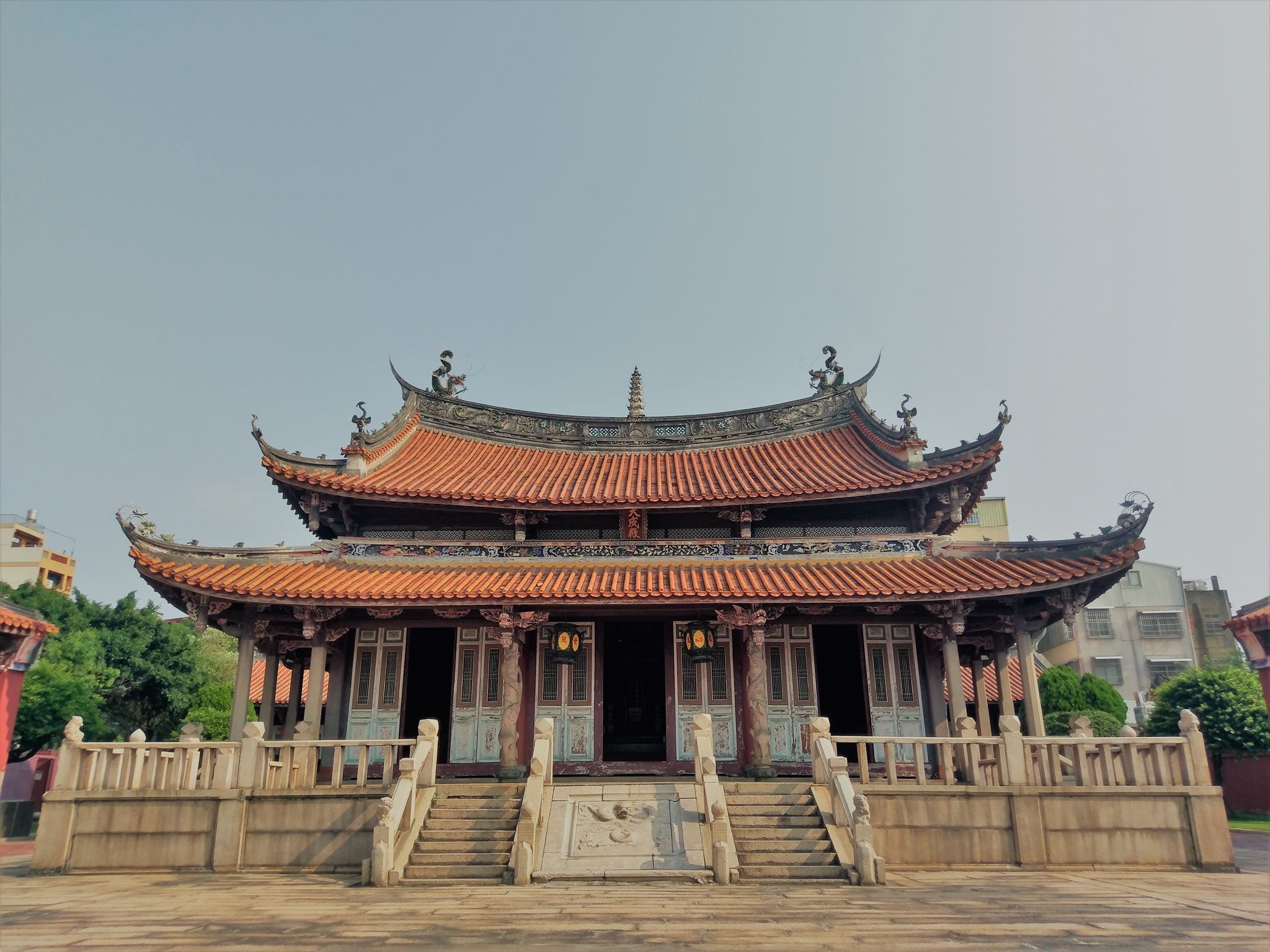RS100 = Top 100 Religious Scenes of Taiwan.
The "Top 100 Religious Scenes of Taiwan" encompass a hundred iconic religious sites and activities that were chosen via public vote and announced by the Ministry of Interior on Nov. 22, 2013. these sites embody the history of early Taiwanese settlers and illustrate both diversity and the island's religious landscape.

Changhua Confucius Temple is a classic mid-Qing dynasty Confucian temple in Taiwan
彰化孔子廟是清代中葉臺灣官建孔廟的代表作
Changhua Confucius Temple had the most complete education system of any public educational institution in Taiwan in the early Qing Dynasty. Baisha Academy, one of the four major educational institutes in Taiwan at the time, was set up here. For this reason, this Confucian temple played an important role in the cultural and educational development of Central Taiwan. Several inscription plaques bestowed by Qing emperors still hang in Dacheng Hall. Among them, one with the inscription “heretofore unseen” from the Yongzheng Emperor and another inscribed with the phrase “as great as heaven and earth” from the Qianlong Emperor has the highest historic value. Another celebrated object kept in the temple is the large bronze bell commissioned by former County Magistrate Yang Gui-sen. Other special features of the hall include the sides of Dacheng Hall’s foundation platform, which are adorned with patterned tiles, and the lifelike dragon carved on the center staircase, which serves as a symbolic passage for the emperor and divine deities. Changhua Confucius Temple is the only Confucian temple in Taiwan to have brick carvings of flowers and birds inlaid in the walls on either side of its Ji Gate (the Halberd Gate), and six heavenly vessels, which represent the idea that Confucius was a conduit between heaven and earth due to his vast knowledge, along the roof ridge of its Lingxing Gate (the outer gate of a typical Confucian temple). For this reason, Changhua Confucius Temple is considered to be an exemplar of mid-Qing dynasty architecture in Taiwan, particularly in comparison to the Confucian temples of Fengshan, Chiayi, Danshui, etc., that either no longer exist or are poorly preserved.
彰化孔子廟是清朝初年臺灣學宮體制最完整的學府,臺灣四大書院之一的白沙書院即設於此,也是臺灣中部文教發展之重要象徵。大成殿樑上懸掛數座清代皇帝所賜匾額,以知縣陽桂森 (生卒年不詳) 所鑄之銅製大鏞及雍正帝「生民未有」、乾隆帝「與天地參」巨匾,最具歷史價值。大成殿台基邊堵以花磚砌成,御路莽龍造型栩栩如生,而戟門牆垛則鑲嵌花鳥磚雕,櫺星門脊六支「通天筒」,為全臺孔廟僅見。相較於已經不存在的或不完整的鳳山、諸羅、淡水等地孔廟,彰化孔子廟可謂清代中葉臺灣官建孔廟的代表作。
Changhua Confucius Temple was the original location of Changhua County School. Changhua was granted county status in 1723. In 1726, County Magistrate Zhang Gao hired craftsmen from Zhangzhou, Quanzhou, and Chaozhou in mainland China and had building materials shipped over to Taiwan to build the temple. In 1745, Tamsui Tongzhi (a subordinate official of the head of Taiwan Prefecture) Zeng Yue-Ying, who was in charge of Changhua County, had Baisha Academy constructed to the left of the temple. In 1786, Minglun Hall and the County Educational Administration Office were destroyed during an anti-Qing rebellion led by Lin Shuang-wen, a Ming dynasty loyalist. Later in 1816, Wenchang Shrine, dedicated to the God of Literature and Culture, was built on the old site of Minglun Hall, and Baisha Academy was reconstructed. In 1830, County Magistrate Li Tingbi had the temple renovated. The foundation was raised by over two feet and the pillars in front of Dacheng Hall were replaced with two dragon columns and twenty stone pillars, while the terrace was also raised by more than two feet. Minghuan Shrine, which commemorates celebrated officials, Xiangxian Shrine, which commemorates respected local gentry, and the ritual equipment storage facility and musical instrument storage facility were also built next to Chongsheng Shrine, which honors the ancestors of Confucius. The layout of these structures forms the basis of the temple complex today. During the Japanese Colonial Period, Baisha Academy was torn down due to a road widening project. The temple underwent major repairs twice after World War II and was proclaimed a national historic site in 1983.
彰化孔子廟原為彰化縣學所在,清雍正元年(公元 1723 年)彰化設縣。清雍正 4 年(公元 1726 年),由知縣張鎬 (生卒年不詳) 主其事,聘請大陸漳州、泉州、潮州師父,由大陸將建築材料船運來臺,創建彰化孔子廟,清乾隆 10 年(公元 1745 年),淡水同知攝彰化縣事曾曰瑛 (公元 1708 年 - 1753 年) 於廟左側興建白沙書院,乾隆 51 年(公元 1786 年)林爽文事件,明倫堂與學署毀於戰亂,直到嘉慶 21 年(公元 1816 年)在明倫堂舊址興建文昌祠並重修白沙書院。清道光 10 年(公元 1830 年)李廷壁知縣回任,重修夫子廟,將基地墊高 2 尺 2 寸,殿前改用龍柱 2 支及石柱 20 支,露台亦增高 2 尺 2 寸,崇聖祠旁增設名宦祠與鄉賢祠及禮器庫、樂器庫,奠定了今日孔子廟的規模與格局。日治時期白沙書院因道路拓寬而拆除,孔子廟於戰後歷經兩次重修,民國 72 年 (公元 1983 年) 列為國定古蹟。
The temple is open from 8:30 a.m. to 5 p.m. Entry is free of charge. The main gate is closed all year round except on the 28th of September when the annual ceremony to honor Confucius is held. Visitors can use the side doors. The temple is closed on Mondays, election days and during folk festivals.
開放時間 08:30 至 17:00,平日大門緊閉,僅 9 月 28 日釋奠典禮時開啟,參觀可由側門出入,免收門票。星期一、選舉及民俗節日休館。
Please put the cache back the position you found it, and bring a pen for log.